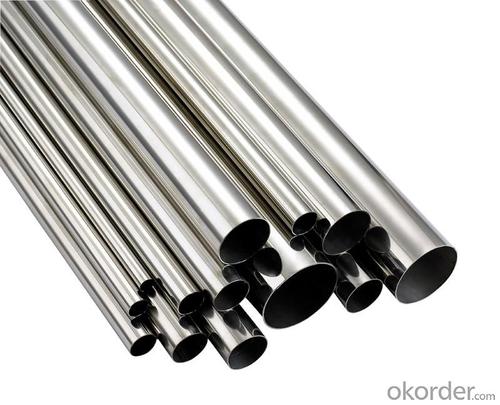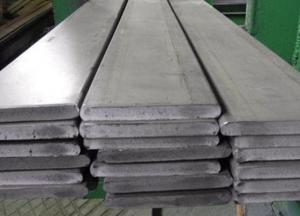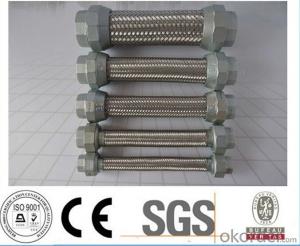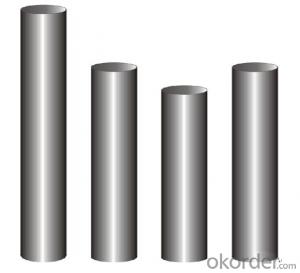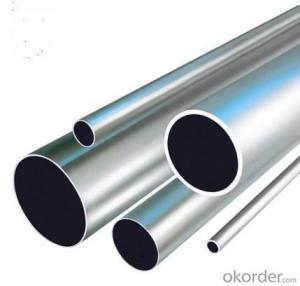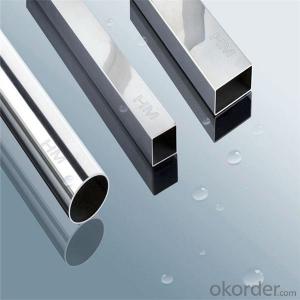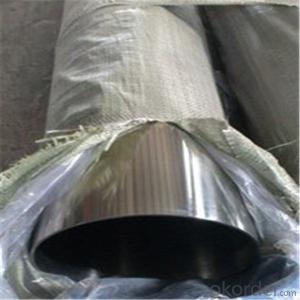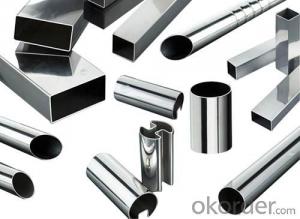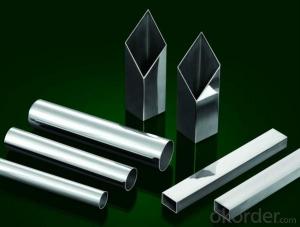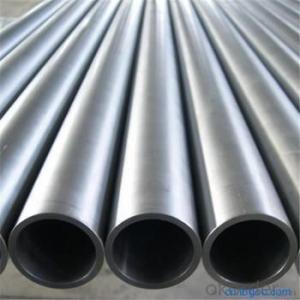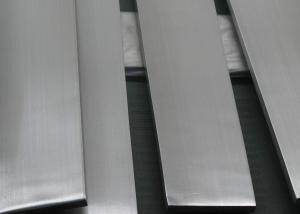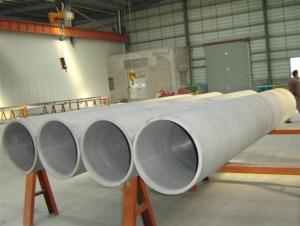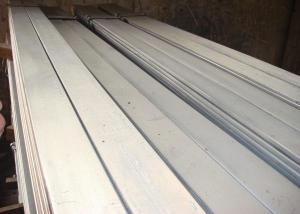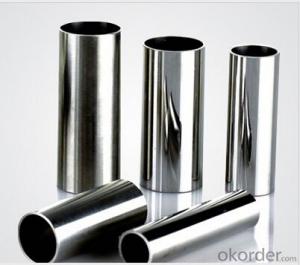STAINLESS STEEL PIPES 201 pipe
- Loading Port:
- China Main Port
- Payment Terms:
- TT OR LC
- Min Order Qty:
- -
- Supply Capability:
- -
OKorder Service Pledge
OKorder Financial Service
You Might Also Like
Description:
Stainless Steel Pipe
Material:
304 321 316 310
Packing:
In bundle
MOQ:
5 TONS
Comparison of standardized steels
| EN-standard Steel no. k.h.s DIN | EN-standard Steel name | SAE grade | UNS |
|---|---|---|---|
| 1.4109 | X65CrMo14 | 440A | S44002 |
| 1.4112 | X90CrMoV18 | 440B | S44003 |
| 1.4125 | X105CrMo17 | 440C | S44004 |
| | | 440F | S44020 |
| 1.4016 | X6Cr17 | 430 | S43000 |
| 1.4408 | G-X 6 CrNiMo 18-10 | 316 | |
| 1.4512 | X6CrTi12 | 409 | S40900 |
| | | 410 | S41000 |
| 1.4310 | X10CrNi18-8 | 301 | S30100 |
| 1.4318 | X2CrNiN18-7 | 301LN | |
| 1.4307 | X2CrNi18-9 | 304L | S30403 |
| 1.4306 | X2CrNi19-11 | 304L | S30403 |
| 1.4311 | X2CrNiN18-10 | 304LN | S30453 |
| 1.4301 | X5CrNi18-10 | 304 | S30400 |
| 1.4948 | X6CrNi18-11 | 304H | S30409 |
| 1.4303 | X5CrNi18-12 | 305 | S30500 |
| | X5CrNi30-9 | 312 | |
| 1.4541 | X6CrNiTi18-10 | 321 | S32100 |
| 1.4878 | X12CrNiTi18-9 | 321H | S32109 |
| 1.4404 | X2CrNiMo17-12-2 | 316L | S31603 |
| 1.4401 | X5CrNiMo17-12-2 | 316 | S31600 |
| 1.4406 | X2CrNiMoN17-12-2 | 316LN | S31653 |
| 1.4432 | X2CrNiMo17-12-3 | 316L | S31603 |
| 1.4435 | X2CrNiMo18-14-3 | 316L | S31603 |
| 1.4436 | X3CrNiMo17-13-3 | 316 | S31600 |
| 1.4571 | X6CrNiMoTi17-12-2 | 316Ti | S31635 |
| 1.4429 | X2CrNiMoN17-13-3 | 316LN | S31653 |
| 1.4438 | X2CrNiMo18-15-4 | 317L | S31703 |
| 1.4362 | X2CrNi23-4 | 2304 | S32304 |
| 1.4462 | X2CrNiMoN22-5-3 | 2205 | S31803/S32205 |
| 1.4539 | X1NiCrMoCu25-20-5 | 904L | N08904 |
| 1.4529 | X1NiCrMoCuN25-20-7 | | N08926 |
| 1.4547 | X1CrNiMoCuN20-18-7 | 254SMO | S31254 |
Stainless steel’s resistance to corrosion and staining, low maintenance and familiar lustre make it an ideal material for many applications. There are over 150 grades of stainless steel, of which fifteen are most commonly used. The alloy is milled into coils, sheets, plates, bars, wire, and tubing to be used in cookware, cutlery, household hardware, surgical instruments, major appliances, industrial equipment (for example, in sugar refineries) and as an automotive and aerospace structural alloy and construction material in large buildings. Storage tanks and tankers used to transport orange juice and other food are often made of stainless steel, because of its corrosion resistance. This also influences its use in commercial kitchens and food processing plants, as it can be steam-cleaned and sterilized and does not need paint or other surface finishes.
Stainless steel is used for jewelry and watches with 316L being the type commonly used for such applications. It can be re-finished by any jeweler and will not oxidize or turn black.
Some firearms incorporate stainless steel components as an alternative to blued or parkerized steel. Some handgun models, such as the Smith & Wesson Model 60 and the Colt M1911 pistol, can be made entirely from stainless steel. This gives a high-luster finish similar in appearance to nickel plating. Unlike plating, the finish is not subject to flaking, peeling, wear-off from rubbing (as when repeatedly removed from a holster), or rust when scratched.
Architecture[edit]
Stainless steel is used for buildings for both practical and aesthetic reasons. Stainless steel was in vogue during the art deco period. The most famous example of this is the upper portion of the Chrysler Building (pictured). Some diners and fast-food restaurants use large ornamental panels and stainless fixtures and furniture. Because of the durability of the material, many of these buildings retain their original appearance.
Type 316 stainless is used on the exterior of both the Petronas Twin Towers and the Jin Mao Building, two of the world's tallest skyscrapers.[17]
The Parliament House of Australia in Canberra has a stainless steel flagpole weighing over 220 tonnes (240 short tons).
The aeration building in the Edmonton Composting Facility, the size of 14 hockey rinks, is the largest stainless steel building in North America.
Bridges[edit]
Cala Galdana Bridge in Minorca (Spain) was the first stainless steel road bridge.
Sant Fruitos Pedestrian Bridge (Catalonia, Spain), arch pedestrian bridge.
Padre Arrupe Bridge (Bilbao, Spain) links the Guggenheim museum to the University of Deusto.[18]
Monuments and sculptures[edit]
The Unisphere, constructed as the theme symbol of the 1964-5 World's Fair in New York City, is constructed of Type 304L stainless steel as a sphere with a diameter of 120 feet, or 36.57 meters.
The Gateway Arch (pictured) is clad entirely in stainless steel: 886 tons (804 metric tonnes) of 0.25 in (6.4 mm) plate, #3 finish, type 304 stainless steel.[19]
The United States Air Force Memorial has an austenitic stainless steel structural skin.
The Atomium in Brussels, Belgium was renovated with stainless-steel cladding in a renovation completed in 2006; previously the spheres and tubes of the structure were clad in aluminium.
The Cloud Gate sculpture by Anish Kapoor, in Chicago US.
The Sibelius monument in Helsinki, Finland, is made entirely of stainless steel tubes.
The Man of Steel (sculpture) under construction in Rotherham, England.
Other[edit]
- Automotive bodies
The Allegheny Ludlum Corporation worked with Ford on various concept cars with stainless steel bodies from the 1930s through the 1970s, as demonstrations of the material's potential. The 1957 and 1958 Cadillac Eldorado Brougham had a stainless steel roof. In 1981 and 1982, the DeLorean DMC-12 production automobile used stainless steel body panels over a glass-reinforced plasticmonocoque. Intercity buses made by Motor Coach Industries are partially made of stainless steel. The aft body panel of the Porsche Cayman model (2-door coupe hatchback) is made of stainless steel. It was discovered during early body prototyping that conventional steel could not be formed without cracking (due to the many curves and angles in that automobile). Thus, Porsche was forced to use stainless steel on the Cayman.
- Passenger rail cars
Rail cars have commonly been manufactured using corrugated stainless steel panels (for additional structural strength). This was particularly popular during the 1960s and 1970s, but has since declined. One notable example was the early Pioneer Zephyr. Notable former manufacturers of stainless steel rolling stock included the Budd Company (USA), which has been licensed to Japan's Tokyu Car Corporation, and the Portuguese company Sorefame. Many railcars in the United States are still manufactured with stainless steel, unlike other countries who have shifted away.
- Aircraft
Budd also built an airplane, the Budd BB-1 Pioneer, of stainless steel tube and sheet, which is on display at the Franklin Institute.
The American Fleetwings Sea Birdamphibious aircraft of 1936 was also built using a spot-welded stainless steel hull.
The Bristol Aeroplane Company built the all-stainless steel Bristol 188 high-speed research aircraft, which first flew in 1963.
The use of stainless steel in mainstream aircraft is hindered by its excessive weight compared to other materials, such as aluminum.
- Jewelry
Valadium, a stainless steel and 12% nickel alloy is used to make class and military rings. Valadium is usually silver-toned, but can be electro-charged to give it a gold tone. The gold tone variety is known as Sun-lite Valadium
- Q: What are the disadvantages of using stainless steel pipes?
- Although stainless steel pipes offer a multitude of advantages, it is crucial to take into account a few drawbacks: 1. Cost: Stainless steel pipes are typically more expensive than alternative pipe materials such as PVC or carbon steel. This increased cost can impact the overall project budget. 2. Limitations in Corrosion Resistance: Despite its reputation for corrosion resistance, stainless steel is not entirely impervious to corrosion. In certain environments, like highly acidic or alkaline conditions, stainless steel pipes can still corrode over time. 3. Brittle Nature: Stainless steel pipes possess a greater tendency to become brittle compared to other materials. This makes them more prone to cracking or breaking under extreme temperatures or stress. This can be problematic in applications where the pipes are subjected to significant pressure or thermal fluctuations. 4. Difficulty in Modification: In comparison to alternative pipe materials, modifying or altering installed stainless steel pipes is more challenging. This can pose a problem if any changes or adjustments need to be made in the future, as it may require additional time and effort. 5. Heat Conductivity: Stainless steel has lower heat conductivity in comparison to materials such as copper. As a result, stainless steel pipes may not efficiently transfer heat, which can be a disadvantage in applications where heat transfer is crucial. In conclusion, while stainless steel pipes offer numerous benefits, it is crucial to consider these disadvantages when selecting the appropriate material for a specific project.
- Q: Can stainless steel pipes be used for paper and pulp industry applications?
- Yes, stainless steel pipes can be used for paper and pulp industry applications. Stainless steel is resistant to corrosion, chemicals, and high temperatures, making it ideal for handling corrosive liquids and chemicals used in the paper and pulp industry. Additionally, stainless steel pipes provide excellent strength and durability, ensuring long-lasting performance in demanding industrial environments.
- Q: What are the different types of stainless steel pipe coatings?
- There are several types of stainless steel pipe coatings that are used to enhance the durability, corrosion resistance, and aesthetic appearance of the pipes. Some of the common types of stainless steel pipe coatings include: 1. Fusion Bonded Epoxy (FBE) Coating: FBE coating is a thermosetting resin-based coating that is applied to the pipes using an electrostatic spray. It provides excellent corrosion resistance and adhesion, making it suitable for both buried and above-ground applications. 2. Polyethylene (PE) Coating: PE coating is a thermoplastic coating that is applied to the pipes using extrusion. It provides high impact resistance and excellent resistance to chemical substances, making it suitable for pipes used in harsh environments. 3. Polypropylene (PP) Coating: PP coating is a thermoplastic coating similar to PE coating but with higher temperature resistance. It is often used for pipes that transport high-temperature fluids. 4. Polyurethane (PU) Coating: PU coating is a thermosetting resin-based coating that is applied to the pipes using a spray or dip method. It provides excellent resistance to abrasion, impact, and chemicals, making it suitable for pipes used in demanding applications. 5. Zinc Coating: Zinc coating, also known as galvanization, is a metallic coating that is applied to the pipes using a hot-dip process. It provides excellent corrosion resistance and is commonly used for pipes used in outdoor and underground applications. 6. Ceramic Coating: Ceramic coating is a high-temperature resistant coating that is applied to the pipes using a thermal spray process. It provides excellent resistance to abrasion, oxidation, and corrosion, making it suitable for pipes used in high-temperature environments. 7. PTFE (Polytetrafluoroethylene) Coating: PTFE coating is a non-stick coating that is applied to the pipes using a spray or dip method. It provides excellent resistance to chemicals and high temperatures, making it suitable for pipes used in the chemical and food industries. These are just a few examples of the different types of stainless steel pipe coatings available. The choice of coating depends on the specific requirements of the application, such as the type of fluid being transported, the operating temperature and pressure, and the environmental conditions.
- Q: Can stainless steel pipes be used for pharmaceutical manufacturing?
- Pharmaceutical manufacturing can indeed utilize stainless steel pipes. Stainless steel possesses numerous properties that render it suitable for this industry. To begin with, its corrosion resistance is vital in upholding the purity of pharmaceutical products. It can withstand chemical attacks and endure rigorous cleaning procedures without deteriorating or contaminating the medications. Furthermore, stainless steel's easy cleanability and sanitization are essential in maintaining a high level of hygiene during pharmaceutical manufacturing. The smooth surface of stainless steel pipes prevents the buildup of bacteria and other contaminants. Moreover, stainless steel's durability enables it to withstand high temperatures and pressures, making it appropriate for various pharmaceutical processes like sterilization and purification. In conclusion, stainless steel pipes are a dependable and frequently employed option for pharmaceutical manufacturing due to their resistance to corrosion, ease of cleaning, and durability.
- Q: What is the difference between 304J2 and 316J2 stainless steel pipes?
- The main difference between 304J2 and 316J2 stainless steel pipes lies in their chemical composition. While both alloys contain the base elements iron and carbon, 304J2 stainless steel pipes have a higher concentration of chromium and nickel, while 316J2 stainless steel pipes have a higher concentration of chromium, nickel, and molybdenum. This makes 316J2 stainless steel pipes more resistant to corrosion, especially in environments with chloride ions, such as saltwater or marine applications. Additionally, 316J2 stainless steel pipes have better heat resistance and are more suitable for high-temperature applications.
- Q: What are the different types of stainless steel pipe insulation?
- There are several types of stainless steel pipe insulation available, including fiberglass, mineral wool, foam, and elastomeric foam. These materials provide different levels of thermal performance, durability, and resistance to moisture and chemicals, allowing users to choose the most suitable option for their specific needs.
- Q: Can stainless steel pipes be anodized?
- No, stainless steel pipes cannot be anodized. Anodizing is a process used to create a protective layer on the surface of metals, primarily aluminum. Stainless steel already has a naturally occurring oxide layer that provides corrosion resistance, making anodizing unnecessary.
- Q: Can stainless steel pipes handle high-velocity fluid flow?
- Yes, stainless steel pipes are capable of handling high-velocity fluid flow due to their excellent strength, durability, and resistance to corrosion.
- Q: Are stainless steel pipes resistant to crevice corrosion?
- Yes, stainless steel pipes are generally resistant to crevice corrosion. Due to their composition, which includes a significant amount of chromium, stainless steel pipes form a protective oxide layer that prevents the formation of crevices and minimizes the risk of crevice corrosion. However, the resistance to crevice corrosion may vary depending on the specific grade of stainless steel and the environmental conditions in which the pipes are used.
- Q: What is the difference between seamless and drawn-over-mandrel stainless steel pipes?
- The manufacturing process and physical properties set seamless stainless steel pipes and drawn-over-mandrel (DOM) stainless steel pipes apart. When it comes to seamless stainless steel pipes, a solid cylindrical billet of stainless steel is pierced and then extruded to create a seamless tube. This process guarantees a uniform and consistent thickness throughout the pipe, resulting in a flawless and seamless look. Seamless pipes are renowned for their exceptional strength and resistance to pressure, making them suitable for applications that demand reliable and resilient piping systems. On the other hand, drawn-over-mandrel stainless steel pipes are formed by transforming a solid cylindrical billet into a hollow tube through a series of drawing operations. A mandrel is then used to refine the tube's shape and size accuracy. This method ensures that the pipe has a uniform wall thickness and a smooth inner surface. DOM pipes are known for their precise dimensions and tight tolerances, which make them ideal for applications that require exact fitting and unobstructed flow, such as those found in the automotive and hydraulic industries. In terms of physical properties, seamless stainless steel pipes generally boast higher tensile strength and yield strength compared to DOM pipes. This characteristic makes seamless pipes more suitable for high-pressure and high-stress applications, like those found in the oil and gas industry. DOM pipes, on the other hand, excel in dimensional control and surface finish, making them perfect for applications that require precise dimensions and smooth flow, such as those found in the automotive and hydraulic industries. To summarize, the primary difference between seamless and drawn-over-mandrel stainless steel pipes lies in their manufacturing process and physical properties. Seamless pipes are created by extruding a solid billet, resulting in a smooth and seamless appearance. DOM pipes, on the other hand, are formed by drawing a hollow tube from a solid billet, resulting in exceptional dimensional accuracy. The choice between these two pipe types depends on the specific requirements of the application, including pressure resistance, dimensional accuracy, and surface finish.
Send your message to us
STAINLESS STEEL PIPES 201 pipe
- Loading Port:
- China Main Port
- Payment Terms:
- TT OR LC
- Min Order Qty:
- -
- Supply Capability:
- -
OKorder Service Pledge
OKorder Financial Service
Similar products
Hot products
Hot Searches
Related keywords

